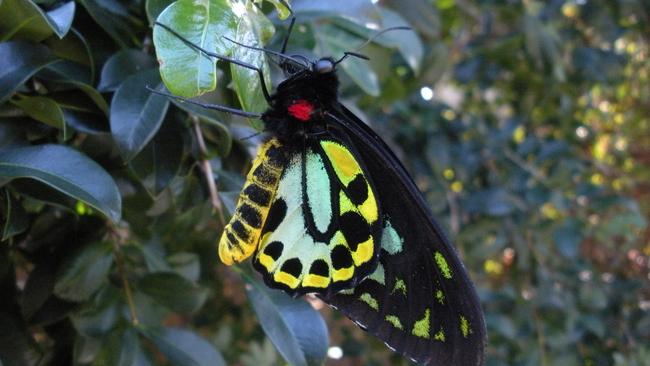Richmond Birdwing butterfly breeding program in full flight
The Richmond birdwing butterfly - which is listed as vulnerable - is making a comeback in the wild due to a successful captive breeding program.
Local
Don't miss out on the headlines from Local. Followed categories will be added to My News.
THE Richmond birdwing butterfly is making a comeback in the wild due to a successful captive breeding and release program which aims to see it taken off Queensland’s threatened species list.
Since 2010, the Department of Environment and Science (DES)-led program has seen more than 500 Richmond birdwing butterflies released into the wild.
“It is hoped these releases will boost wild populations of this exquisite butterfly, so in the future it can be taken off Queensland’s threatened species list,” a DES spokesman said.
Why are there so many butterflies around Brisbane?

“The butterfly is currently listed as vulnerable in Queensland due to habitat destruction and an introduced weed called the Dutchman’s pipe, which is poisonous to the butterfly.”
The spokesman said the butterfly’s recovery was a critical priority for the government, and the Queensland Parks and Wildlife Service selective breeding program is supported by Seqwater and the Wildlife Preservation Society of Queensland (WPSQ), including its special interest group the Richmond Birdwing Conservation Network.
MORE NEWS:
Rare Dalmatian magpie spotted at Brisbane park
Rare blue kookaburras sighted in Queensland
Australia’s animal crash hot spots revealed
Seqwater, WPSQ and DES have provided 120 vines to David Fleay Wildlife Park on the Gold Coast, to help raise adult birdwing butterflies in a specially-refurbished enclosure.
The vines are used for egg-laying by adult female butterflies and for feeding the hungry caterpillars until they reached the pupal stage, usually between 25 and 50 days.
Once adults emerge, individuals from different geographic locations are selectively mated in the captive facility to achieve increased levels of genetic diversity.
The next generation of caterpillars are then released into their natural habitat, where they become adult butterflies and eventually breed to improve the abundance and genetic diversity of wild populations.
Seqwater Field Ranger Mitchell Thomas-Carr said the conservation program was successfully boosting numbers of the birdwing butterfly around Hinze Dam and Numinbah Valley.
“Aside from our involvement in the restoration of the enclosure and supplying birdwing vines, Seqwater is planting host vines in birdwing habitat to further protect and conserve the butterflies,” Mr Thomas-Carr said.
“Seqwater is also removing the noxious Dutchman’s pipe vine from our estate around Hinze Dam, which the butterflies mistake for the birdwing butterfly vine and is toxic to caterpillars.
“And we’re providing eggs and young larvae of birdwing butterflies found on Dutchman’s pipe leaves at Hinze Dam to DES for the captive breeding program.”
WPSQ Project Manager Matt Cecil said the captive breeding program was a key component of efforts to save this species from further population decline.
“Addressing the genetic decline within isolated Richmond birdwing butterfly populations is a key process in the recovery of this amazing butterfly,” Mr Cecil said.
“Having all stakeholders working together throughout this project has been a major part of the ongoing successful recovery of the Richmond birdwing butterfly.
“The Richmond Birdwing Conservation Network is identifying and mapping future corridors so the butterflies can be reintroduced to other areas.”
Richmond birdwing butterfly (Ornithoptera richmondia) fast facts:
■ Female birdwing butterflies have a wingspan of 16cm; males have a wingspan of 13cm
■ Females have brown or black wings with extensive white, cream or yellowish markings
■ Male wings have iridescent green edges with extensive green or blue markings
■ Eggs are about 2mm in diameter and are laid on the undersides of soft leaves
■ The larvae are cannibalistic
■ The butterflies mostly live in subtropical rainforest in southeast Queensland and northeast New South Wales
■ In low to mid elevation habitats they feed exclusively on the birdwing butterfly vines (Pararistolochia praevenosa)


